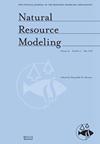输入和水文参数不确定性在极端水文模拟中的作用
IF 2.1
4区 环境科学与生态学
Q3 ENVIRONMENTAL SCIENCES
引用次数: 4
摘要
量化水文极端事件模拟中可能的不确定性来源对于更好地管理极端情况下的风险和水资源规划非常重要。本研究工作的主要目标是确定和解决输入数据质量和水文参数集以及不确定性传播在水文极值估计中的作用。这包括使用两个目标函数(NSE表示洪水,LogNSE表示低流量)、20000 Hydroiska Byråns Vattenbalansavdelning(HBV)水文参数集和三个频率分布模型(Log‐Normal、Pearson‐III和广义极值)来识别和估计它们对洪水和低流量量级的贡献。由于不同的流态和产流机制,不确定性对模拟流量的影响在选定的三个集水区中并不一致。结果表明,高流量频率建模的不确定性主要来自于输入数据的质量。在低流动频率的建模中,导致总不确定性的主要因素是模型参数化。QT90(90年一遇极端洪峰流量分位数)分位数的总不确定性表明,输入数据和水文参数集的相互作用在总不确定性中起着重要作用。相反,在QT10(10年一遇的极低流量分位数)估计中,输入数据质量和水文参数显著影响总的不确定性。这意味着,主要因素及其相互作用可能会在水资源管理以及洪水和干旱风险管理中造成相当大的风险。因此,在灾害风险管理、水资源规划和环境影响评价中忽视这些因素及其相互作用是不可行的,可能会导致相当大的风险。本文章由计算机程序翻译,如有差异,请以英文原文为准。
The role of input and hydrological parameters uncertainties in extreme hydrological simulations
Quantifying possible sources of uncertainty in simulations of hydrological extreme events is very important for better risk management in extreme situations and water resource planning. The main objective of this research work is to identify and address the role of input data quality and hydrological parameter sets, and uncertainty propagation in hydrological extremes estimation. This includes identifying and estimating their contribution to flood and low flow magnitude using two objective functions (NSE for flood and LogNSE for low flow), 20,000 Hydrologiska Byråns Vattenbalansavdelning (HBV) hydrological parameter sets, and three frequency distribution models (Log‐Normal, Pearson‐III, and Generalized Extreme Value). The influence of uncertainty on the simulated flow is not uniform across all the selected three catchments due to different flow regimes and runoff generation mechanisms. The result shows that the uncertainty in high flow frequency modeling mainly comes from the input data quality. In the modeling of low flow frequency, the main contributor to the total uncertainty is model parameterization. The total uncertainty of QT90 (extreme peak flow quantile at 90‐year return period) quantile shows that the interaction of input data and hydrological parameter sets have a significant role in the total uncertainty. In contrast, in the QT10 (extreme low flow quantile at 10‐year return period) estimation, the input data quality and hydrological parameters significantly impact the total uncertainty. This implies that the primary factors and their interactions may cause considerable risk in water resources management and flood and drought risk management. Therefore, neglecting these factors and their interaction in disaster risk management, water resource planning, and evaluation of environmental impact assessment is not feasible and may lead to considerable risk.
求助全文
通过发布文献求助,成功后即可免费获取论文全文。
去求助
来源期刊

Natural Resource Modeling
环境科学-环境科学
CiteScore
3.50
自引率
6.20%
发文量
28
审稿时长
>36 weeks
期刊介绍:
Natural Resource Modeling is an international journal devoted to mathematical modeling of natural resource systems. It reflects the conceptual and methodological core that is common to model building throughout disciplines including such fields as forestry, fisheries, economics and ecology. This core draws upon the analytical and methodological apparatus of mathematics, statistics, and scientific computing.
 求助内容:
求助内容: 应助结果提醒方式:
应助结果提醒方式:


